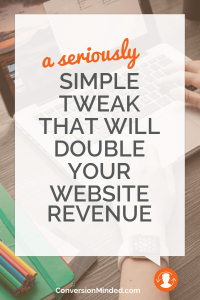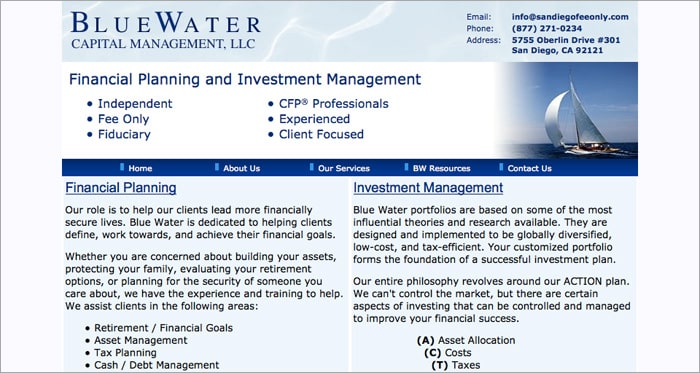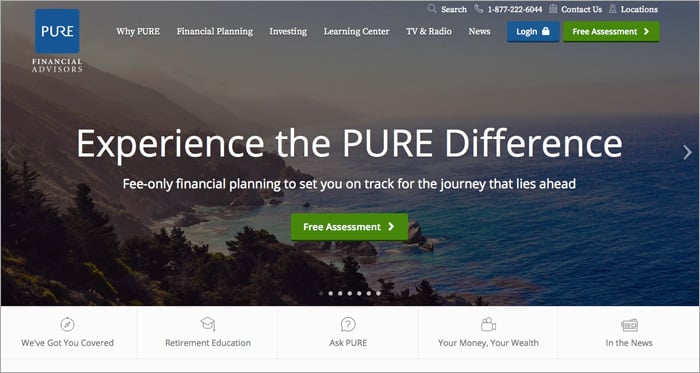After months of experimenting and preparation with social media and blogging, you’re finally starting to get some traffic to your website!

Aside from creating quality content regularly, leveraging social media and using the highest quality images for your blog, often times we need a little something more to give us a boost.
Luckily, there’s an easy way to give potential customers that push. And it’s a simple tweak you can make right on your home page.
Here’s an example:
Let’s say you want some advice on how to manage your money so that you can save for the future and still enjoy all the things you want to do today, like go on vacations.
So you decide to look for someone who can give you some guidance. You search Google for “financial planner” and find these two websites:
Which one makes you want to find out more about what they do?
I’ll bet it’s the second one. Because the reason to do business with you is the first thing you see, with an image that reinforces the value you’ll experience.
Contrast that to the first one, where the first thing you notice is their logo and then some bullet points about them, followed by a lot more text about them.
Now compare these examples to your own website. When someone arrives on your home page, is it immediately clear what your business is about? Will visitors know right away the value they can expect?
So many entrepreneurs overlook this step when they’re building their websites. And then even though they start getting traffic from organic search, social and email campaigns, that traffic doesn’t translate into more leads or customers.
If you find you’re getting decent traffic but no targeted leads, it’s the message (or value proposition) on your home page that may be at fault. In this article, I’m going to show you how to create a strong value proposition that will convert clients and bring you more sales.
Here’s what I’m going to cover:
- What is a value proposition?
- What goes into creating a value proposition?
- How to create a winning value proposition
- An example of a strong value proposition
- A value proposition worksheet
What’s a value proposition?
Using the earlier example, if you’re a financial advisor and someone searches Google for “financial planner” and they land on your site, you want them to stay.
So this is your chance to communicate your value in 30 seconds or less and pull them deeper into your content.
Your value proposition tells people why they should do business with you. It should clearly state what you do, who you do it for and how it helps.
Being very clear on these three things is what’s going to convince people not to hit the back button and search for another trainer.
In a nutshell, a value proposition is a clear statement that
- explains how your product solves customers’ problems or improves their situation (shows relevancy),
- delivers specific benefits (aspect of value),
- tells the ideal customer why they should buy from you and not from the competition (point of differentiation).
It should pass the word of mouth test
Your value proposition should be so simple that even a 10-year-old can tell his friends about your offer and how they would benefit.
But it shouldn’t be so simple that it forgets the value mention. A statement like “We provide financial advisory services,” doesn’t mean anything to people. There’s just not enough information here for people to remember you, let alone tell their friends.
On the other hand, a value proposition that people can’t understand enough to explain to their friends what your offer is and how they can benefit is equally damaging.
Take this example:
“Bringing together military and industry veterans in the relentless pursuit of our clients’ success. We understand that the financial industry is first and foremost a service industry and we seek to be consistently recognized for exceptional client service resulting from teamwork and living by our principles.”
Do you have any idea what they do? Ready to run and tell your friends about it? Didn’t think so.
Your value proposition isn’t the place to impress people with how smart you are. Technical jargon-propositions like this will kill your chances of converting clients. Stay away from them at all costs.
Remember to keep the focus on your customer:
- What do they want?
- Why are they here?, and
- How do you help?
Use the right language
Your value proposition needs to be in the language of your ideal customer and join the conversation that is already going on in their minds. You need to speak in the words your customers use to describe your product and how they benefit from it, not your own.
Don’t try to guess what that language is. The way you speak about your services is often very different from how your customers describe it. You need to find out by either interviewing your customers and your sales team or through social media.
What goes into a value proposition?
The value proposition is usually a block of text (a headline, sub-headline and one paragraph of text) with a visual (photo, hero shot, graphics).
While value propositions come in many forms, here’s a basic formula you can use:
- Headline
- Sub-headline or short paragraph
- List of key benefits or features
- An image
The headline is your attention grabber and the most important part of the value proposition. It’s what people will spend the most time looking at. Give them one short sentence here summarizing the end-benefit you’re offering.
You sub-headline is where you add more detail about what you do, who you do it for and why it is useful. This should be no more than 2-3 sentences.
Use bullet points to show benefits and features people can expect.
An image is worth a thousand words, so be careful which image you choose. Show your product or some image that emphasizes your main message. An irrelevant picture will confuse people and won’t do much to emphasize your message.
Evaluate your current value proposition by checking whether it answers the questions below:
- What product or service is your company selling?
- What is the end-benefit of using it?
- Who is your target customer for this product or service?
- What makes your offering unique and different?
Use the headline-subhead-benefits-visual formula to structure the answers.
How to create a winning value proposition
The best value proposition is clear: what is it, for whom and how is it useful? If those questions are answered, you’re on the right path. Always strive for clarity first.
If your value proposition makes people squint their eyes and tilt their head, you’re doing it wrong. If they have to read a lot of text to understand your offering, you’re doing it wrong. Yes, a sufficient amount of information is crucial for conversions, but you need to draw them in first before you get in to all that.
Here are some steps to help you come up with a winning value proposition:
1) Create a Customer Avatar
You need to know what motivates your ideal customers in order to craft a message that’ll make them take notice.
The best way to get this kind of insight is to create a Customer Avatar, which is a profile of your ideal customer.
Do you have a favorite client that you love working with, one that just happens to be a highly profitable client? Use that profile for your customer avatar.
If you don’t have clients yet, think about who would value most from your products or services. Why would they want to choose you over someone else? Think about what problems they have and how you can uniquely help. Then just update your avatar later one when you know more about your ideal clients.
Here’s what you need to include in your profile:
- What do they do?
- What are their basic demographics: background, age, income, gender?
- What’s the biggest challenge they face?
- What are their aspirations?
- What would make their job/life easier?
- Are there any other people involved in the decision-making process (spouse, boss). If so, you’ll need to create an avatar for each.
- Have they used other products or tools similar to yours, and how did they like them?
You may discover some things you didn’t expect.
Don’t be afraid to focus solely on this one profile. You really want your avatar to reflect highly profitable clients only, and let the others fall off. It’s time to get laser-focused on your ideal customer (the ones that are super easy to work with, love what you do, and bring in the most revenue).
(NOTE: Want my easy 3-step process to create your customer avatar? Get my Customer Avatar Worksheet.)
2) Define what makes you truly unique
When I think about what separates me from other marketers, the first thing I think about is why clients pick me.
And then I think, “I’m good at what I do, I have a great service and I provide a great value.”
But here’s the thing. These are the same exact things that everyone else can can say. Service and value are a given today and something that customers expect. These claims will get you a seat at the table, but they’re not tipping points.
You really need to reflect on the one aspect of value that you excel at over your competitors. This is the secret to creating a strong value proposition, especially if what you sell isn’t all that unique.
In my case, I’ve learned that my tipping point is that I’m a marketing team in-a-box, kind of like a CMO on steroids. When clients work with me they don’t have to shop for a separate writer, designer, business strategist, SEO person or IT person. So my real value is that I make marketing easy for companies by saving them time and energy and holding their hand through the process.
You might discover that it’s the little things that really matter to customers, like all the things you overlook and are already doing that absolutely thrill them. For instance, as a remodeler it might be how clean and tidy you keep the project site that matters most to your customers and not your craftsmanship or attention to detail.
Knowing these little things will make all the difference in the way you market yourself. When you clearly communicate them throughout your website, you’re going to immediately attract the exact customers who want to work with you.
Here’s an example of a great value proposition
Check out Wix’s homepage:
There are tons of website builders out there, so how does Wix stand out from the pack?
They focus on how easy it is to create a beautiful website.
Which makes sense, because if you think about it many people looking to build their own website are entrepreneurs like you and me who have a million things on their to-do list.
Chances are their background isn’t in technology, so being able to easily build a website is super important to them.
Do you know what’s super important to your customers? Make sure they see that message right away.
If you’re saying too many things, or you’re saying them in ways that confuse people or don’t convey value, it means your value proposition is unclear. And if it’s unclear to you, it’s definitely going to be unclear to visitors.
Value proposition template
It can be tricky to know where to start writing your value proposition, so I’ve provided a template to help get your creative juices flowing. First write out your responses to these questions. Take your time and try to answer them as completely as possible.
- What product or service are you offering?
- Who is your ideal customer?
- What do they need or desire?
- What problems do they have?
- How do you solve their problems?
Then plug in your answers here (you don’t have to follow this template exactly, but it should have these basic components).
For_____________________(your ideal customer)
Who____________________(what does your customer seek or need)
(Your product) is a ________________________ (describe you or your product)
That____________________(your solution/key benefit)
Examples:
For non-technical marketers
Who struggle to find return on investment in social media
Our product is a web-based analytics software
That translates engagement metrics into actionable revenue metrics.
For businesses and enterprises
Who want to stay ahead of the competition
Sales Cloud is the world’s #1 sales application
That helps salespeople manage accounts, contacts, and business opportunities, and collaborate instantly from anywhere on any device.
A good way to test your value proposition is to create two home pages and run Google ads to see which one performs better. You won’t be able to test your actual ad conversions this way because there are other factors involved, but you’ll be able to tell which value proposition is stronger. Keep testing and refining your message and product/market fit until it’s solid.
(NOTE: Want my easy 3-step process to create your customer avatar? Get my Customer Avatar Worksheet.)





It is indeed a jungle to convert more visitors into customers, but I think you are sharing some wonderful tips, and certainly inspiration for those willing to take the visitor perspective on their websites. It can’t be said enough: we have to watch everything we do from the visitor’s perspective.
When he or she is looking for a solution, we provide it.
When he or she is convinced of our online credibility, it’s time to take in that all important click, and just as green boxes are positive – and red boxes are negative – so colors will do the trick in many instances.
Thanks for inspiring your readers. 🙂
Henrik, thanks for your comments. I couldn’t have said it better myself 🙂 Our biggest hurdle with websites is understanding what potential customers are looking for, what they need, and then making sure we communicate our solution right up front so that it’s crystal clear. If a 10-year-old can understand your value proposition, you know you’re on the right track! Funny how this is one of the hardest things to nail, right?